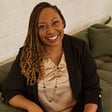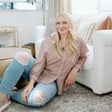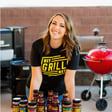Introduction to the Show and Guest
00:00:05
Speaker
Every great product idea comes from your clients, and you just have to listen for it. Welcome to The Brands at Book Show, where we help creative, service-based businesses build their brands and find more clients. I'm your host, Davy Jones.
00:00:30
Speaker
Today's guest is Shay Cochran, founder of the Essie Stock Shop and Social Squares.
Shay's Transition to a Product-Based Business
00:00:35
Speaker
If you're not familiar with those brands, the Essie Stock Shop is a styled stock photography shop that provides access to premium styled stock photography for your brand, while Social Squares is a membership site that provides monthly access to styled stock photos for things like social media. I'm really excited about this episode and it's a bit different than the others.
00:00:55
Speaker
Shay and I are chatting about how she stopped trading her hours for money and how she turned a service-based business into a product-based business. Before SE Stock Shop, Shay was doing brand and product photography for creative businesses, until a remark from one of her clients led to an idea that eventually turned into the SE Stock Shop. Shay shares a lot of great business wisdom as she walks us through founding both the SE Stock Shop and Social Squares, so make sure you're ready to take notes.
00:01:24
Speaker
Also, if you head on over to the show notes for this episode, you'll be able to access a special offer if you're looking to give something like Social Squares a shot. Be sure to check out the show notes at davianchristo.com for the resources we mentioned during this episode, and I'd like to hear from you about what kind of content you'd like to see on the Brands That Book podcast as we move
Listener Engagement and Feedback
00:01:41
Speaker
forward. I'd also like to know what episodes you've enjoyed most so far and why. To leave your feedback, head on over to the Davian Christo Facebook page and send us a message. Now, on to the episode.
00:01:58
Speaker
Well, we have Shay Cochran here with us on the Brands That Book Show today. And Graham Cochran, Shay's husband, was actually one of the first three episodes here on the Brands That Book Show. And I've been excited to interview Shay for a while. Shay, I think we've been talking about this for a while, at least since Creative at Heart last November. Yeah.
00:02:16
Speaker
Yeah, I'm a little insulted that you chose Graham because we go farther back than you and Graham, but it's okay. Hopefully, hopefully I can make it up during the episode here. We have a lot of fun things to chat about today. And I am kind of glad that we're chatting now because we have a whole new business in social squares to chat a little bit about towards the end of this episode. And in addition to that,
00:02:40
Speaker
I mentioned this to Graham back when I interviewed him, but I feel like it must be like, do you guys have your own little mastermind? Is that how it is being married to him? It is kind of like a 24-hour mastermind in our house.
00:02:52
Speaker
For worse, yes. It's awesome. Just the resource that you all have in each other. That's really cool.
Challenges in Business Transition
00:02:59
Speaker
We are going to be talking about taking a service-based business and turning it into a product. During my emails to you, I was making up words. I think I was calling it product devising. I don't know if that's a word or not, but I'm excited to chat about taking what used to take up your time
00:03:17
Speaker
and turning it into something that you could sell that didn't take any of your time and probably is more profitable than what you were doing one-on-one. So I'm excited to chat about that. And I told you this before the episode, but I don't know the pre-SC stock shop, Shay. So I'm excited to hear a little bit more about how you got started in commercial photography. So can we start there? Like, how did you get started in photography? How did you get started in commercial photography specifically?
00:03:46
Speaker
Yeah. So I started dabbling in photography in college, but I heard what most people have heard that the only way to make money in photography is to be a wedding photographer. So I started second shooting weddings for a friend of mine who was a phenomenal photographer back in college and post college. I sort of just started my own.
00:04:06
Speaker
Portrait and wedding photography business, following the typical trajectory for photographers, did not go to school for photography, but I did end up running my own portrait and wedding photography business for about eight years. Part-time, I mean, I was no Caitlyn James, let's just say that. And this was back in 2005, I'm pretty sure she was already fully on her way.
00:04:31
Speaker
So I actually did portrait and wedding photography for a very, very long time for about eight years. And then when I, when we had our first daughter, that sort of first year we moved to a new state. So I was starting from scratch and have any word of mouth referrals or anything like that. We moved from Virginia to Florida and had our first child a few months after that. And it was around that time that I was starting to be honest with myself about
00:04:58
Speaker
A, that's not really working for our family. You guys know shooting weddings is mentally, emotionally, and physically exhausting and usually on the weekends. So it became increasingly hard to like shoot a wedding until midnight and then get up at 6 a.m. for feedings, you know? That's if you got to sleep through the night. So I couldn't just go home and sleep off a wedding like I used to be able to.
00:05:24
Speaker
pre-parenting. So you know, you have a baby and it really changes everything. So I started to get honest with myself about it not really being a good fit for our family anymore. And also just my passion and it was really starting to wane. So I moved to Florida where there was so many incredible wedding photographers. I don't know if I would assume Florida probably attracts a lot of destination weddings and that kind of thing. So wedding photography is a big industry here.
00:05:50
Speaker
And I was surrounded by people that were doing a great job that really loved it. Their heart was really fully in it. And I just was growing in my awareness that I did not love their weddings as much as I was trying to tell my brides that I did. So I knew they needed to pull out of that. And the hard part about that was that I didn't know where I was going to go from there. I honestly had not thought about commercial photography at that point. I just had eight years of wedding work on a website and all this expensive gear.
00:06:19
Speaker
and had no real idea what I was gonna do after that.
Journey to Commercial Photography
00:06:23
Speaker
So somewhere in that year when I just kind of pulled the plug on the wedding work, something planted the idea in me that I could try commercial work. My only memory of that shift was I was like in line at HomeGoods and I'm looking up at like the big commercial banner images that are behind the checkout counter and it's just photos of stuff, beautiful photos of products and I'm like,
00:06:48
Speaker
Somebody had to take those and shooting inanimate objects feels a little bit easier to me right now than photographing people. And it can be done whenever, you know. Yeah, exactly. So that kind of got the wheels turning and that was around the time that I reached out to Emily Lay, who was, I was just kind of racking my brain like, okay, if I want to try shooting objects, if I want to, I had no idea if I could style, but let's just start somewhere.
00:07:15
Speaker
If I want to transition into maybe trying some product photography or commercial photography, I just racked my brain on who do I know that has a retail business that they're selling something that they would maybe be crazy enough to let me just experiment with it. And I had a very loose connection with Emily at that time and reached out to her was basically like, Hey, would you do a trade? I need branding. I'll take some product photos for you. Some flood planner, you know, way back when.
00:07:43
Speaker
It went really well. So she agreed to do the trade. I loved it. She loved it. She was happy with the images. I felt like I could have done that work endlessly for three days straight and not grown tired of it. And that was when I kind of figured out that I could actually style. I at least had a good starting point and that there was a need because the more I thought about it,
00:08:05
Speaker
You know, we know that big companies, big brands work with commercial photographers. We know that's a thing. But if you're a small business and you have a retail Etsy shop that sells handmade soaps or something like that, you're usually getting your portrait or wedding photographer friend to take pictures of your process. At best, I think. At best. Or you're just trying to take it yourself.
00:08:28
Speaker
Exactly and that's maybe working and maybe not working because that's not their thing and it really is a totally different technique and there's just a lot that's very different about portrait photography and product photography that makes it hard for the average person to execute it if they don't know about it.
00:08:45
Speaker
What I realized in starting to do that was that, hey, there's all of these small businesses. I mean, Etsy was, I don't know how long Etsy had been out, but it certainly wasn't, hadn't been around for very, very long. So you have all of these new entrepreneurs and they have terrible photos on their websites. And there's nobody who's raising their hand to say, oh, I take photos of products. So as soon as I said that,
00:09:14
Speaker
I take photos of products, not for these big massive brands like J. Crew, but for normal small businesses, it was kind of like people flocked to that idea because there just wasn't anybody else that had really raised their hand that I knew of that was saying, Hey, I do commercial photography for small businesses. I'll do your product photography. And so it just kind of clicked and it started
00:09:35
Speaker
working out and moving very quickly and word of mouth spread among business owners. Obviously Emily Lay has like a wonderful following. So that was a really fortunate for me that that worked out really, really well. And that really played a large part in kind of kick-starting that commercial photography phase of my career.
00:09:56
Speaker
And when you made the shift to product, because commercial photography in and of itself is sort of a big branch of photography, did you find that the people that you were working with needed sort of the same kinds of images for their websites? Yeah, I think working with Emily obviously attracted a lot of the people that were contacting me after her and after I was starting to put that work out there were female creative business owners.
00:10:25
Speaker
what they needed for their site, even beyond product photography, if we start to talk about brand imagery for their site, more or less followed a certain sort of equation, I guess, of we need images for our website, we need images to sell our product, we need images for online promotion and that kind of thing. So yes, from business to business, what they needed was fairly similar.
00:10:48
Speaker
And so at what point, so you're doing this one to one, it sounds like it was a better fit and something that you really enjoyed, especially since I imagine most of that work could be done Monday through Friday. It didn't have to be done, you know, on Saturdays. And I'll say like, especially after Krista had Jack,
00:11:05
Speaker
and we went and shot our first wedding, you know, I mean, there's lining up childcare and there was, you know, Chris had to figure out when to pump like it during the during the day, you know, there's just so many different pieces. So I can imagine that was just kind of a better life fit as well. But as you were doing that, at what point did you start realizing, okay, basically, at what point did you start thinking I can transition this into more of a product that I sell, I could create, you know, stock images for these brands and start selling those.
00:11:35
Speaker
So that idea, I have to credit one of my clients with that idea, actually. And I think that's kind of like, we'll kind of circle back around to this, but I think every great product idea comes from your clients.
00:11:50
Speaker
And you just have to listen for it. Like I didn't really come up with anything genius and new. So I was starting to get more small business clients and obviously like I have 24 hours in my day, just like you have 24 hours in your day. And then if you're parenting, you know, it feels like you have like two hours of actual time in your day.
00:12:09
Speaker
I look back and I wonder how I wasted so much time. You know what I'm saying? I have to get all my work done within a certain timeframe now and I just think to myself, what was it like having these extra hours and how am I not living on a yacht somewhere having had that opportunity to have so many extra hours? But I'm sorry, back to... No, it's so true. I have so many hours to work with in between momming and I can only fit in one or two clients into that time.
Pricing and Scaling Challenges
00:12:39
Speaker
And I started to get more and more people that were reaching out to me, that were wanting to work with me. And because I had such limited time and there was such demand, I was able to start raising my prices. And that was great in terms of like the trade-off for my time. But what ended up happening is very quickly I priced myself out of the small business demographic. So then I started attracting
00:13:04
Speaker
larger companies and that's fine. That's, that is one path, but I was a little bit sad that there were all these small business owners that now still didn't really have anybody that was doing product photography for them. And I always kind of felt bad when I was like, here's my pricing and they couldn't afford it. And you know, we know that there's a place for that, but I really do love that small business female entrepreneur in her first like one to five years of business. That's still,
00:13:32
Speaker
the group of people that I really love and wanna serve. So one of my clients at the time who had hired me to do some product photography set in passing, she had peaches in her brand, like in her branding. And she was like, I just wish that I could just get you to just shoot a bunch of generic photos with peaches in them that I could just use in different places. I could use it on my website. I could use it in my print collateral pieces and I could use it. And at that time, I had already been trying to think like,
00:14:02
Speaker
I've already hit a ceiling on like dollars for hour trade off. How can I serve these smaller companies that can't necessarily afford to hire me now? And like, how can I make this scalable? Because you see the limitations right away. And so when she said that it just clicked, but like, Oh, wait, I could create, you know, generic isn't really a fair word, but non product specific images.
00:14:29
Speaker
that multiple small businesses could use. And then I could sell them online. And then obviously I can like still reach that target market that I really loved of small business owners. And in those early years of business, I could still help them, but it was scalable. And it just like, all of a sudden everything started to click that that was the perfect solution to the next sort of phase of commercial photography.
00:14:53
Speaker
Um, for me, so I really have to credit one of my clients for, for coming up with that idea and being like, you know what, I would like this. And I think other people would like it too. And it just made perfect sense. And at that time, you know, there was no stocksy, there was no unsplash and all of these super cool places you can get really cool, non-corpority feeling stock imagery. It was really just like I stock and Getty images back then. And the images were in general, very.
00:15:22
Speaker
very corporate, very cold, lended towards more masculine imagery. So there just wasn't really any other place to go for it. So it made a lot of sense.
00:15:34
Speaker
that idea made a lot of sense in sort of like, if you looked around at the industry, what was available and what the need was. Yeah, so that I can't even take credit for it. But I think it's one of those things where in hindsight, yeah, it makes a ton of sense. You know, there's a market for stock photography, because there are stock photography companies out there like Getty, who are probably making a killing even at that time on the stock images that that they're selling. And there's this missing piece in the market, because those images are, like you said, very, I guess, more masculine,
00:16:03
Speaker
more corporate oriented. Looking back, I think it does make a lot of sense. However, I'm still interested in hearing about how you started to dial in that a little bit because you have this one brand who's saying, well, if you could just take these images of peaches, but then how did you go about thinking, okay, well,
00:16:20
Speaker
Well, that's great. I mean, I can I can definitely take these images of a bunch of, you know, more. And again, I know generics that the probably the the best term, but for lack of a better one right now, these generic images with with peaches, how'd you go about deciding, okay, well, what other kinds of imagery am I going to create so that it can reach a wide enough audience without being too generic or, you know, too specific, you know, like it could only serve this this peach branded company? I think that was a combination of
00:16:51
Speaker
who was asking me for images, which was female creative business owners. And then what did I like in terms of creating? So I was drawn to a certain aesthetic and this demographic also was drawn to that same aesthetic. So I kind of started from that point, like, okay, I can shoot fruit. I can shoot pencils. I can shoot, you know, and I would just sort of,
00:17:18
Speaker
raid my closet or the office depot and be like, what do I
Early Success of Essie Stock Shop
00:17:24
Speaker
think people could use on their website when I think about the particular clients that I was already working with? So they were stationary designers, they were web designers, they were graphic designers, imitation designers, that kind of thing. So what was usable for them? And it evolved from random things, just kind of shooting random things to shooting desktops and thinking through, okay, a lot of people have
00:17:48
Speaker
digital products like wedding stationery or like a ebook or PDF or something and they need a way to display that. But instead of sending it to me to photograph, what if I could create a visual desk space that they can then just lay that product on, add a little drop shadow. There you go. You have at least something that's going to beautifully present your product without having to pay for custom personalized photography for your business.
00:18:18
Speaker
way more palatable to these newer businesses. So it kind of just builds from there. And then it was a matter of, you know, you'll see this theme or I'm going to kind of keep talking about this theme of feedback and listening to what your clients are purchasing and wanting. And that has really, really shaped the trajectory of the business from the beginning. But back then it was like, okay, in the Etsy shop, what is selling? And desktops were selling.
00:18:43
Speaker
that seemed to be the thing that people really liked. So I was like, OK, let's shoot more desktops. Let's go there. So that very first version of the shop, can you tell us what was in it? Because again, I only know the Etsy stock shop in its maturity. So when I go there, it's so built out. There's something really for everyone within the niche that you serve. So what did that very first Etsy shop kind of look like? What products did you decide? OK, I'm going to launch with these.
00:19:12
Speaker
It was very experimental. It was really just what do I have that I can shoot on white that I think people might
00:19:20
Speaker
So it had some just random images like that of colored pencils and things like that. And then some desktops. I'm trying to remember what else was even in there. We started to build from there and have like mugs for people that overlaid mugs or every request we got or any bit of feedback that I got, I say we, it was just me. Any kind of requests I got, I used as an idea. So it was pretty random. It was definitely on Etsy, which was great and awful.
00:19:48
Speaker
I mean, Etsy is fantastic. It was relatively inexpensive for me to use Etsy. I couldn't afford to build out my own site platform. So I just kind of was trying to work with what I have and then constantly adjust based on what was selling. And I rocked that Etsy shop for a few years. I want to say it was like two or three years that I was able to kind of build out that and experiment on Etsy. So nothing impressive, but there just wasn't really anything
00:20:18
Speaker
like it at the time. And I think that was just what gave it the interest or kind of attracted the attention was that there just wasn't really a novel idea, I guess. Yeah. And what I love about that and just doing what you can with what you have is that you didn't start this Shopify site that was going to be more expensive and pour all this money into an idea that wasn't necessarily proven out at the time. I want to hear a little bit more about the feedback that you gather. I know that you
00:20:48
Speaker
I think at least you sent a survey at least once a year that you do for the Etsy stock shop. But even going back to that Etsy shop, what did it look like marketing this new product? Do you think that's really how you drove traffic to it? Is that people were looking for stock images, but not the typical kinds of stock images that they were finding through something like Getty? I was trying to think through the answer to that question because I really kind of don't know. I don't know how it works.
00:21:16
Speaker
But at this time, you're still shooting one to one with people. I'm still shooting some commercial clients. Yep. Um, I was still shooting multiple times a year for a small set of commercial clients on. So that was like one source of income. And then the stock shop was kind of like a, let's just see what happens. Like, let's see if anyone will buy this. So I kind of maintained both for a while. And it's funny because it actually took a few years. I remember the conversation I had with Graham.
00:21:41
Speaker
I don't remember at what point in time it was, but the stock shop had become, in my mind, a pretty legitimate income generator. And I remember Graham being like, isn't that just a small side thing? And I'm like, babe!
00:21:55
Speaker
It's legitimately producing like a great salary. So then it was kind of, it took a little offer to click that like, Oh, this is like a thing or something to this. But how did we market it? I mean, do you feel like you had a little bit more time to experiment and give the SE stock shop to get legs having been that you are still shooting one to one? Yes. I mean, that obviously helped.
00:22:17
Speaker
pay the bills. It's not like you had to scale it right away off the bat, which I'm sure there's an advantage to that because you can take a little bit more time listening to feedback early on. I'd be interested, did you hear feedback from your one-to-one people even as you had the SE stock shop live? At what point did there ever become an intersect where it's like you're working with these one-on-one people and they're like, I've also bought something on the SE stock shop?
00:22:45
Speaker
Yeah, yeah, absolutely. It's funny because I'm trying to think. So the first full year of business was 2014. Do you remember when Instagram came out? You know, I don't figure with that. I don't know. Yeah, I don't think that was on Instagram though. And so I think maybe we used Facebook to talk about it a little bit, but I really don't know. Like how, how did that kid, how did that get traction? Maybe I might've newly been on Instagram. So that might've obviously facilitated
00:23:14
Speaker
A, the fact that I'd raise my hand to say I shoot products, so then I'm drawing the attention of small businesses, and then when they're contacting me, I'm saying, you know what, here's my rates, but if this isn't a good fit, or if I'm not taking in more clients, I have this shop on Etsy. Now, that sounds abysmally slow to be directing people in that way, but it really was organic growth. The other funny part of that is that styled stock
00:23:38
Speaker
in quotes was not really a thing. So I don't think people would really have been searching for it. So I'm trying to think, how did people find us? Because it would just have been up to people searching Etsy. But I did have a little bit of a newsletter. I did obviously have a little bit of momentum in the small business entrepreneur industry market because of my work with Emily and some of the other people that I had worked with at the time. And I think that was like just enough.
00:24:07
Speaker
traffic and sort of recognition to get it off the ground. And I think because it was a product that just made sense and solved a real need, that it didn't take a lot of convincing. So it didn't take, you know, I think about like when electric vacuums were first invented, that probably wasn't a tough sell, you know? When Q-tips were invented, that probably wasn't a tough sell. You're like, okay, yep, I see the need. So it's just a matter of like,
00:24:37
Speaker
how much is this going to cost me? Yeah. And you're going to tell other people about it. And I think we should discount the collaborations or partnerships as a way to grow. And I'm sure the combination of Emily's network combined with all these other people that you're serving, I'm sure there was a serious word of mouth element to that. Yeah, I think so. And it being novel. But I think what was easy about it
00:25:02
Speaker
You know, nothing comes easy, but what was easy about it was that it solved a real need. So I didn't really have to convince people. It wasn't like I was trying to sell art prints and convince you to like, you need these art prints or something like that. It just, it solved a real felt need and it was the only real place to have that need mitigated for female creative business owners in this way. So it was not a hard sell.
00:25:28
Speaker
Looking back at that entire experience, and I'm sure maybe it's best to talk about this in the context of social squares, which is kind of the next, I don't know if it's necessarily iteration of SE stock shop, because they are two different things, but evolution of ideas along those lines, I guess. But looking back at the SE stock shop, is there anything that you would do differently now, like knowing what you do, you would have started, you know, right off the bat? You know, I don't think so. To be honest with you, I think
00:25:58
Speaker
In looking back on those, so now let's see, we started the first full year was 2014. So, you know, we're, we've been doing this for a little while now, not quite as long as I even did the other business, but I don't know that there were, that I can look back and say like, these are specific mistakes I made. There were certainly challenges just like there are now. So I was always having to.
00:26:23
Speaker
work with my limited time because I wanted to spend more time being a mom than I wanted to spend running the business. Always faced with the limitation of my knowledge and what I know how to do and obviously when you're doing something that hasn't really been done before you're just kind of trying to figure it out. But there was really just so much working in my favor in the sense that
00:26:44
Speaker
there was not a quote unquote style stock industry at the time, short of just what was happening at Getty and I stock. There wasn't sort of this like more tangible, accessible level of a style stock industry like there is now. And the benefit of that, the benefit of any time you're doing something new is that, I mean, yes, it's challenging that you're doing something new. So there's no real like roadmap to success. But the flip side of that is that there's no rules. Like you really can just,
00:27:12
Speaker
make it up as you go. So I had no one to look to for pricing. I had no one to look to for how to market this. I could just kind of feel it out and just sort of do whatever I wanted to do and price it where I wanted to price it. And so that could, that's a challenge, but it also was like a huge benefit that I could just make up my own rules as I went. So I don't know. I think, you know, when I think about like mistakes that I made along the way,
00:27:39
Speaker
ask me that in like three to five years because I think that the season that I'm in now and the season that I have been in for the past few years has is much harder than those like early honeymoon years of starting the business and having a product idea that was novel and that was solving a real need and there were no industry standards there were no rules that I had to abide by there was no competition there was those really were really sweet years and now obviously
00:28:07
Speaker
the whole industry has changed and there's much more. My business has grown. We've talked about social squares a little bit. So there have been new iterations and things that we've had to sort of adjust to accommodate. So I feel like this is probably the hardest season that I've been in so far. And I'm likely to be making the most mistakes right now in those early years. But I will say, you know, a few things
00:28:34
Speaker
The best things I did, which I think is helpful, mistakes are helpful. And I'll let you know about that in like three to five years, all the things that I should have done differently. But the things that worked well, that worked well from the beginning was that I started building a newsletter immediately. That was a holdover from wedding.
Adapting to Customer Feedback
00:28:50
Speaker
I had already started to build a newsletter. So building newsletter immediately with a really desirable opt-in really gave me a leg up from the beginning. I would say entering the market as a premium product, I think was a good idea because
00:29:05
Speaker
Since then, it has sort of been like a race to the bottom in terms of how other people are pricing styled stock. But since I didn't come in to that environment, I got to create the environment. So I got to position myself as a premium provider and sort of say, here's the value of this product and
00:29:22
Speaker
I could just define that for myself as long as people would pay it. What's fascinating about that is that it's a premium product within another level because you're serving people one-to-one, which is your most premium product, obviously. This product, it's a premium product for people who can't afford you. Exactly. That was why the pricing wasn't just whimsical, it was logical because if someone's paying
00:29:48
Speaker
$5,000 for commercial product, for commercial imagery to build their brand around, then it's not really that much of an ask to say, this image that you can start to build your brand around is $60. Okay. That's a much easier investment than five or $6,000. So it was a very linear, logical pricing decision.
00:30:08
Speaker
But I'm grateful that I did that early. And we've had to make adjustments and we've had to iterate as the industry has grown and changed and we have to accommodate for the needs and the competition and sort of what's out there now. But I was glad that we did that early. I think another thing that really worked was surveying from the beginning. You kind of talked about that a little bit. Every single step and every single iteration from just being a one-to-one service-based provider to having a
00:30:38
Speaker
online passive income style business has been, every decision has been a response to customer feedback, which really takes the guesswork out of what you should do. If you can build in that open communication from the beginning, and we just did that simply through surveying. I mean, when you're on Etsy, you don't have a lot of, you're not installing apps to like automatically generate customer service, feedback, emails and things like that. It was very rudimentary.
00:31:06
Speaker
But we, at the very least, since we had an email list, we could ask people what they wanted and whether they liked the service and what they wanted, what they were enjoying and what they weren't finding and what they thought of it. And so we did from starting year two, I think we started surveying out once a year, really coming through that feedback and then constantly
00:31:27
Speaker
making changes and iterating in response to that feedback. And I think that was just something that worked well. We've iterated the business a lot since then. That determines the decision to build a Shopify website. That influenced the decision to shoot more desktops and be more desktop-heavy. That influenced the decision to stick to a light, bright, airy, feminine
00:31:48
Speaker
creative, business-focused aesthetic that shaped the creation of social squares. Everything has really been a response to customer feedback. I think having that from the beginning has been one of the best things and it really has been a saving grace because I'm not that smart. I would not just sit around and come up. I'm not your typical entrepreneur that has 20 million ideas a day. See, this is the thing. I have a problem with
00:32:18
Speaker
surveys and things like that because there's two parts to that. Yeah, you should absolutely be listening to feedback and that's good advice and obviously that's a large part of how you've grown the SE stock shop. But the second part of that, and this is why you can't say that you're not that smart because you are that smart, is because the second part of that is combing through that feedback and figuring out what is legitimate to respond to and what's not.
00:32:42
Speaker
because I think everybody gets a lot of feedback that's absolutely meaningless and they would be best off if they had never heard it. What happens is if we're always so dependent on feedback or we don't know how to interpret that data we're getting. I think that's, as I listen to you hear, that's one of the things that I admire most about you and your business is that
00:33:05
Speaker
Yeah, you have that open door policy, so to speak. You're sending out surveys. You're proactive in getting feedback. But it's incredible to me how you've taken that feedback and decided, okay, this is what the market needs. The second part of interpreting feedback is looking at sales numbers. That's your best form of feedback.
00:33:26
Speaker
There have been plenty of times where we've put out let's say on instagram like do you guys want us to make a desktop in this color and everyone's like yes, and then nobody buys it you're like okay. That wasn't a good idea, so you absolutely have to learn how to filter the feedback and I think.
00:33:44
Speaker
what trumps even maybe what people are asking is what people are buying. So it's kind of finding a way to marry those two things is what are people buying? And then how can we iterate in a way that most people are asking us to iterate? You're absolutely right, though. You're absolutely right. You can't and you really do need to take those both of those things into consideration. So I want to hear about the creation of social squares.
00:34:08
Speaker
So you were doing one-on-one, you know, brand and product photography, then that had led you to starting Essie Stockshop. And I know for a long time while you did Essie Stockshop, you were still doing the one-on-one stuff. I don't think you're doing as much one-on-one, right? Yeah. So maybe some collaborations, but I think most of those are four things like the Essie Stockshop.
00:34:25
Speaker
So you have the SE stock shop and the SE stock shop is still in existence, but now you have social squares as well. Social squares also a stock, a styled stock photography solution. How is it different than SE stock shop and what led you to create this offering? Yeah, so SE stock shop was the first one. That was the Etsy turned Shopify that's, you know, that started in end of 2013 and is still going and similar product line.
Essie Stock Shop's Role in Branding
00:34:54
Speaker
The idea behind the stock shop from the beginning was creating really high value, high resolution, high technical quality, commercial grade imagery that brands could
00:35:08
Speaker
incorporate into their entire visual brand and really build their brand around. So we're talking about the images that are used in the creation of their website, in their sidebar buttons, in their opt-ins, in their blog headers. Now it's their Pinterest images and things like that. But it was, the idea was, okay, you have your logo and you have your font choices and you have your color palette. And that's a very important piece of it, but there's something about imagery that brings your brand to life and sort of prompts a
00:35:38
Speaker
emotional response. So we kind of started to educate on the tie between imagery or the power of imagery within branding as a part of your brand, not just your logo and your font, your color choices. But it's the difference between a drawing of a plate of cookies and a picture of a steaming plate of cookies. There's just something about a photographic element that lends or sort of aids in an emotional tie to the brand. So
00:36:05
Speaker
the stock shop was always intended to be images like that where you selected a small set of them and you sort of built them into your branding and they stayed with you and you could crop them down and use them in a ton of different ways on a ton of different at a ton of different client touch points, whether it was print collateral or web design or all of that kind of thing. And you would stick with that set of imagery until you changed your brand or you wanted to refresh or that kind of thing. So that was sort of the idea behind the stock shop.
00:36:33
Speaker
high res images, little bit higher price investment. But one of the things that we were, for years we were consistently asked like, can you make a less expensive variation? And then the other thing was we started to see when we would ask people, how are you using your imagery that as Instagram and Pinterest grew in popularity, I mean, when we started, I don't even think Pinterest was around. I remember like asking to be invited to Pinterest or whatever, you know, they had like all these walls up.
00:37:02
Speaker
You had to like request an invitation. So we're seeing Instagram becoming popular and Pinterest becoming popular and all of a sudden people are needing images for all of this. Especially Instagram. I mean, the average business owner posts. I think what we got in our most recent feedback was that most small business owners are posting five to 10 times a week. That is a lot.
00:37:21
Speaker
of images, especially if you're not a photographer. That is an overwhelming amount of imagery that you're trying to come up with. I posted my personal Instagram I think last month once. I posted like five times since Jack was born.
00:37:38
Speaker
I struggle to come up with images for my own Instagram feed and I am a photographer. So you have so many creative businesses out there that are feeling the pressure to keep up with some kind of online presence across social platforms and they don't have the imagery to do it. And our clients that were stock shop loyalists are like, yeah, I can only post the same image cropped so many ways like so many times. So I wish I just need more images. I need more images at a lower price point for
00:38:06
Speaker
Well, I consider them slightly more disposable images. Like the turnaround on the Instagram image or the shelf life of an Instagram image is a little bit shorter than what the stock shop images were intended to be. So it was a felt need in the industry for less expensive
Launch of Social Squares
00:38:24
Speaker
sort of more disposable. They could be low resolution. They could be simpler. Didn't quite need to have all the styling intricacies of the stock shop and a membership. People just have asked for a membership for quite a few years. So it took a long time actually to build social squares to kind of figure out what form of this idea can we execute right now in two days a week, 16 hours a week,
00:38:48
Speaker
with two team members, what can I pull off knowing nothing about membership? So Social Squares started as a sort of, we kind of went with the box, like what are they, like subscription boxes were growing in popularity a few years ago. So we started- Like Dollar Shave Club and stuff like that, yeah. So this is like the Dollar Shave Club of images. Okay, we can, like that we can deliver on, we can figure out how to execute that and we'll deliver 30 images a month to our subscribers, you know, people who are members or subscribers.
00:39:17
Speaker
And that, we did that and that was really successful right out of the gate because again, it just, it solved a real need at a very affordable price point for the right target market whom we'd already attracted and grown and developed a relationship with through the stock shop brand and through the newsletter. And then a few months into that, we started to feel the pain of what people needed. They needed more than just 30 images or they needed to be able to select their own images in their own brand palette. So then you're kind of like, okay,
00:39:45
Speaker
We've got to go to plan B, or phase two, I should say. Not plan B, but what is phase two of this? Phase two of this is people want more images. They need to be able to choose their own images. How quickly can we transition into phase two? It took me probably eight or nine months to even execute on the idea of social squares, which was
00:40:07
Speaker
painfully slow. But but in the grand scheme of things really quick. Yeah, it's true. It felt it felt like a lifetime to me because you hear the complaints or you hear you're getting the feedback like this is what people need.
00:40:21
Speaker
And I just had so much limited time because I was still running a business. So it was just very slow in execution. And then it took a little bit of time to iterate to the second phase of that, which is what it is now. Now it is a monthly membership where you pay a low amount to get access to a huge catalog of images that still speak to the same client base that we have for the stock shop, although we've expanded that a little bit with a little more variety because we have so many different types of business owners.
00:40:51
Speaker
that are subscribers to Social Squares. But I would say we're now in like phase two of even that business and moving on to phase three with a brand new ground up site build that will just have so much more functionality and better features and much better experience, more customized, more individualized experience with the membership. So we have, it feels like business is constantly changing and has always constantly been changing.
00:41:17
Speaker
which is hard. I've never felt like I had it all together. It has always felt like, I used to say even years ago, it feels like I'm laying track in front of a runaway train, just like as fast as I can. And that fast as I can is like super slow because I'm a mom that lives in the burbs that like only works two days a week. And there's all these people that can execute so much faster than me and are so much more knowledgeable, but I'm just trying to lay like the next set of track and then the next set of track and just be,
00:41:46
Speaker
thinking, be listening, be thinking ahead to like, how can I problem solve next? Who knows? Is Instagram going to be around forever? Probably not. So that's hard. It's hard to think about, you know, I mean, it's hard to, it's hard to think like, I mean, but you're right. I mean, something, something will eventually replace it and there'll be something else. And, you know, even over the last couple of years, I feel like things have popped up and you're like, is that going to be it? You know, and it dies in like 48 hours. But what's so interesting about what you're saying, even especially about even
00:42:13
Speaker
Social squares right here and you just refer to this new site build that you're going through You know, I think the perspective from the outside I mean as somebody who I remember you telling me about the social squares idea Not at this past creative at heart, but it was the one before that I think it was the very first one that Graham was at and I can't remember where that was but it was
00:42:34
Speaker
It doesn't feel that long ago. And now Social Squares is this thriving business. So I think the perspective of looking in is a little bit different. It's like we'll look at how fast you move and iterate on different things. But then also, you really do make the most of what you have. And I think that there's such a valuable lesson in there. This new site build will undoubtedly be better and provide a better experience, like you said, than the experience that you're providing right now. But the experience you're providing right now is good.
00:43:03
Speaker
You know that it's a successful product and then also those changes are funded like they're funded and I think that has been very helpful from the beginning is trying to start a business that has very low overhead and I and only making those iterations and changes as the business can support can support them which makes easier decisions then like am I gonna make this major investment and not pan out and I will have taken money out of personal out of our personal bank account
00:43:31
Speaker
we've kind of let the business grow at the rate that it is growing organically instead of trying to force it to grow. And I think that has served us well. I think ironically, the, the things that I look back on and say that was a mistake or times when I invested in something that felt like a big deal or everyone else was saying it was a big deal. And it really at the end of the day was not something that was going to
00:43:57
Speaker
move the ball down the court very much. And one example would be video. Video is fantastic. And I don't know what people are saying now, but a few years ago, I was like, you need video. Everybody needs video. Everyone's website needs to be just one big video. So I'm like, crap, I need to get some video. And for, I won't even go into that story, but there, the times when I've looked back and been like, that was a mistake, especially financially or as an investment, it was when I just listened to too much of like what was trendy.
00:44:26
Speaker
And like, you need to do this and make this major investment when really sort of bootstrapping it has a much better payoff from the beginning. And then you know when you need to make those changes because you do hit that ceiling and you start to feel that pain. So I think some of my mistakes is when I've just sort of listened.
00:44:47
Speaker
gotten caught up in like, Oh, I really need to do this cool thing. Yeah, because everybody else is doing whatever. And I think that's such a valuable point that sometimes we think we need more than what we have in order to get started. I just started another business managing Facebook ads with a few friends of mine. And we started that business without a website, you know, like our first 10 clients came from
00:45:07
Speaker
Yeah, we and I'm, you know, I literally Davey and Krista is a website design and branding company, you know, like it would been pretty easy for me to get and and now we have like a really simple website that Krista actually complains about up for that business. But you know, like, we went out and got clients without, you know, without a website, that's not something that we needed. And if we let that hold us up, you know, we would have got started three months later. You know, and now when we find usually the case, like so many small businesses are like, well, I have to have
Sustainable Business Growth
00:45:37
Speaker
This, this, this, this, and this in place because that's what I see other people doing who are five or 10 years into business when the reality is if you have a good product or a good service or good reputation like you guys have, then the business will find you. The business will find you whether or not you have all the fancy ways of promoting and marketing it. If you have a good product and good reputation and you're doing good work, you will have work.
00:45:59
Speaker
For our website specifically, we're taking it slow because we're still trying to understand exactly what it is people need when it comes to building out their funnels and managing their funnels specifically around Facebook ads. Instead of us getting this massive project, you're going through a website build now so you know how big these projects are. Of course, you've gone through a number of them, sure.
00:46:21
Speaker
but instead of putting all this time and energy into something that we might have to change three months from now because we figure, okay, well actually people need x instead of y, we're taking it what I think is a logical step and it's not preventing us from getting new clients.
00:46:36
Speaker
So, a lot of admiration for you and what you've built from, and it was fun hearing about the one-on-one service days and how that morphed into the SE stock shop because like I said, I've only known the SE stock shop since it's been on Shopify and since it's been sort of a mature product. For people who are interested in the SE stock shop and social squares, maybe you could tell us
00:47:01
Speaker
Again, real quick, what the difference between the two is and what you'll find at each of those places. For people who want to check that out, where should they go? Yeah. If you are building a brand, I would say if you're in the first one to five years of business and you really need some imagery that's going to help you present professionally and not look amateur, if you want a chance to be taken seriously as you're building your business and brand,
00:47:28
Speaker
then the stock shop would be a great place to just take a spin and see if there's imagery that speaks to your aesthetic. I think what the stock shop does is it allows you to say like, hey, I want to be taken seriously as a professional. I have something valuable to offer. I'm not an amateur. I'm not winging it, but it is sort of a way of presenting a polished brand. So I would say go to the stock shop for like
00:47:51
Speaker
large high res images if you find yourself needing images for your PDFs or proposals or your website, your web buttons, images for Pinterest, blog headers, newsletter headers, any of that kind of thing. The stock shop is a great place to start. Usually we encourage people to shop by color. So again, we're talking about like not just disposable imagery, but imagery that you're going to incorporate into your brand.
00:48:15
Speaker
And then also there's some just very functional imagery there. So you guys like the images of desktops with screens. So if you're a designer, there's a way to show off the designs that you're creating and that kind of thing. So you'll find all of that there. And that again is like high res, big image files that you could take like one image and you could crop it into 50 different smaller images to use.
00:48:38
Speaker
And then social squares is if you are managing a brand online, a social media account online and feel that pain that we've talked about of needing imagery to post, to engage with, to present your brand in a professional polished way and also just kind of stay front of mind with clients but you're struggling to come up with imagery or creating imagery just isn't the best use of your time.
00:49:03
Speaker
because we know even just creating images for Instagram can be a total time suck. So if you are feeling that pain of needing imagery for Pinterest, social media, and people use social squares images for much more than just social media, but I would say that's sort of like the primary goal is to provide you with endless, gorgeous images.
00:49:25
Speaker
for your social feeds, then check out social squares. It's just, it's a super fun monthly membership. You can cancel any time, give it a try. And I think what you'll find is that it will meet way more needs than you're even expecting. You'll be able to use it across a lot of different platforms in a lot of different ways. And there's a lot of variety in there. I mean, we have people in there that are everything from like sleep coaches to realtors to web designers to calligraphers. There's just.
00:49:49
Speaker
yoga instructors. I mean, it really runs the gamut in terms of the people that are there, which is great. That encourages me that there's something for everybody in social squares. So you can find social squares at just Google social squares, and the SC stock shop, you can find SC as in
00:50:07
Speaker
you know, my name, Shay Cochran, very original. Well, we will have links to both those places in the show notes for this episode. So, you can head on over to the show notes if you forget that and find links to both Social Squares and SE Stock Shop and maybe even a little promotion for you if you head over there and check that out.
00:50:25
Speaker
also say that we have used the SE stock shop in the past and we are currently subscribed to Social Squares. We know they've been a super valuable resource for us and we appreciate everything that you put out. I'm really excited for this next iteration of Social Squares and to see everything to come in the future, which means that we'll have to have you on for another episode as you get into whatever this next iteration is. Then also to talk a little bit about especially the SE stock shop right now,
00:50:54
Speaker
and just some of the challenges that you're facing, especially as the market gets a little more crowded. And I promise I'll have you on again before I have Graham on again.
00:51:09
Speaker
That's right. But no, a lot of admiration for you both. I've been working with Graham for a number of months now. And I feel like just, you know, what you're saying about focusing on the things that are actually going to move the ball down the court, you know, that resonates with me because I feel like Graham's really helped me focus on on some of those things. So
00:51:28
Speaker
A lot of admiration for your both and what you're doing. And if you haven't listened to Graham's episode, you should go back. I think it's episode three and check that out as well. So thanks for joining me. And I hope you have a great weekend. Absolutely. Thank you. Thanks for tuning into the brand set book show. If you enjoyed this episode, please consider subscribing and leaving a review in iTunes. For show notes and other resources, head on over to DaveyandChrista.com.

















